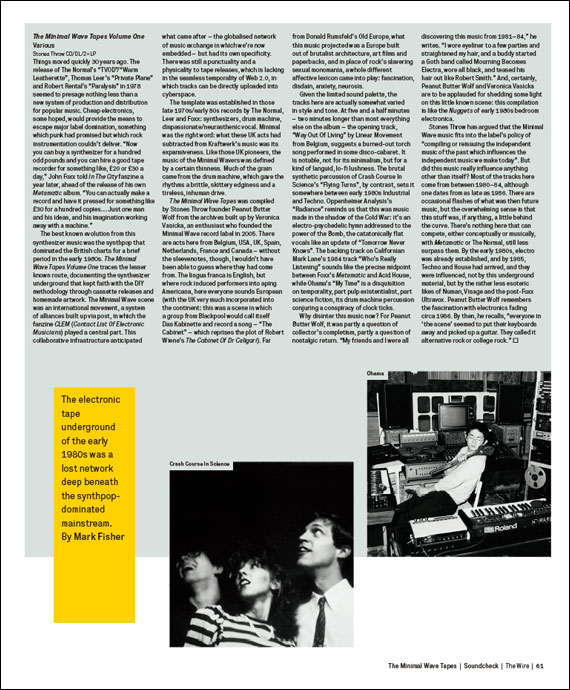“This compilation is like the Nuggets of early 1980s bedroom electronica.” Review by Mark Fisher published in The Wire April 2010
The Minimal Wave Tapes
Various (Stones Throw) CD/DL/2×LP
Things moved quickly 30 years ago. The
release of The Normal’s “TVOD”/“Warm
Leatherette”, Thomas Leer’s “Private Plane”
and Robert Rental’s “Paralysis” in 1978
seemed to presage nothing less than a
new system of production and distribution
for popular music. Cheap electronics,
some hoped, would provide the means to
escape major label domination, something
which punk had promised but which rock
instrumentation couldn’t deliver. “Now
you can buy a synthesizer for a hundred
odd pounds and you can hire a good tape
recorder for something like, £20 or £30 a
day,” John Foxx told In The City fanzine a
year later, ahead of the release of his own
Metamatic album. “You can actually make a
record and have it pressed for something like
£30 for a hundred copies… Just one man
and his ideas, and his imagination working
away with a machine.”
The best known evolution from this
synthesizer music was the synthpop that
dominated the British charts for a brief
period in the early 1980s. The Minimal
Wave Tapes Volume One traces the lesser
known route, documenting the synthesizer
underground that kept faith with the DIY
methodology through cassette releases and
homemade artwork. The Minimal Wave scene
was an international movement, a system
of alliances built up via post, in which the
fanzine CLEM (Contact List Of Electronic
Musicians) played a central part. This
collaborative infrastructure anticipated
what came after – the globalised network
of music exchange in which we’re now
embedded – but had its own specificity.
There was still a punctuality and a
physicality to tape releases, which is lacking
in the seamless temporality of Web 2.0, in
which tracks can be directly uploaded into
cyberspace.
The template was established in those
late 1970s/early 80s records by The Normal,
Leer and Foxx: synthesizers, drum machine,
dispassionate/neurasthenic vocal. Minimal
was the right word: what these UK acts had
subtracted from Kraftwerk’s music was its
expansiveness. Like those UK pioneers, the
music of the Minimal Wavers was defined
by a certain thinness. Much of the grain
came from the drum machine, which gave the
rhythms a brittle, skittery edginess and a
tireless, inhuman drive.
The Minimal Wave Tapes was compiled
by Stones Throw founder Peanut Butter
Wolf from the archives built up by Veronica
Vasicka, an enthusiast who founded the
Minimal Wave record label in 2005. There
are acts here from Belgium, USA, UK, Spain,
Netherlands, France and Canada – without
the sleevenotes, though, I wouldn’t have
been able to guess where they had come
from. The lingua franca is English, but
where rock induced performers into aping
Americana, here everyone sounds European
(with the UK very much incorporated into
the continent: this was a scene in which
a group from Blackpool would call itself
Das Kabinette and record a song – “The
Cabinet” – which reprises the plot of Robert
Wiene’s The Cabinet Of Dr Caligari). Far from Donald Rumsfeld’s Old Europe, what
this music projected was a Europe built
out of brutalist architecture, art films and
paperbacks, and in place of rock’s slavering
sexual monomania, a whole different
affective lexicon came into play: fascination,
disdain, anxiety, neurosis.
Given the limited sound palette, the
tracks here are actually somewhat varied
in style and tone. At five and a half minutes
– two minutes longer than most everything
else on the album – the opening track,
“Way Out Of Living” by Linear Movement
from Belgium, suggests a burned-out torch
song performed in some disco-cabaret. It
is notable, not for its minimalism, but for a
kind of languid, lo-fi lushness. The brutal
synthetic percussion of Crash Course In
Science’s “Flying Turns”, by contrast, sets it
somewhere between early 1980s Industrial
and Techno. Oppenheimer Analysis’s
“Radiance” reminds us that this was music
made in the shadow of the Cold War: it’s an
electro-psychedelic hymn addressed to the
power of the Bomb, the catatonically flat
vocals like an update of “Tomorrow Never
Knows”. The backing track on Californian
Mark Lane’s 1984 track “Who’s Really
Listening” sounds like the precise midpoint
between Foxx’s Metamatic and Acid House,
while Ohama’s “My Time” is a disquisition
on temporality, part pulp existentialist, part
science fiction, its drum machine percussion
conjuring a conspiracy of clock ticks.
Why disinter this music now? For Peanut
Butter Wolf, it was partly a question of
collector’s completism, partly a question of
nostalgic return. “My friends and I were all discovering this music from 1981–84,” he
writes. “I wore eyeliner to a few parties and
straightened my hair, and a buddy started
a Goth band called Mourning Becomes
Electra, wore all black, and teased his
hair out like Robert Smith.” And, certainly,
Peanut Butter Wolf and Veronica Vasicka
are to be applauded for shedding some light
on this little known scene: this compilation is like the Nuggets of early 1980s bedroom
electronica.

